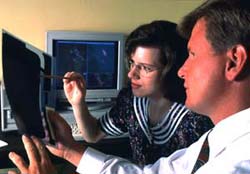Technique reduces time spent on radiation doses

Radiologists some day may be able to calculate radiation doses more quickly and efficiently thanks to a technique developed by Washington University researchers
Researchers at Washington University in St. Louis have developed a technique that drastically decreases the time a radiologist spends calculating radiation dosages and also provides a more carefully controlled dosage with less damage to nearby healthy tissues.
Victor Wickerhauser, Ph.D., Washington University professor of mathematics in Arts & Sciences, and Joseph O. Deasy, Ph.D., assistant professor of radiation oncology in the School of Medicine, have applied a mathematical tool called wavelet analysis to radiation dose distributions simulations and have sped up the dose calculations by a factor of two or more over the standby dose calculation, called a Monte Carlo dose calculation method.
Wavelet analysis is a sophisticated kind of harmonic analysis that is integral in analyzing and compressing data — video, sound, or photographic, for instance — for a wide range of applications.
“Instead of taking hours, it takes minutes,” said Wickerhauser, a pioneer in wavelet analysis who has applied the tool on analysis of fingerprints for the FBI, among many other applications. “The speed allows the radiation dose to be controlled more carefully, which will provide less damage to adjacent healthy tissues.”
To get an accurate estimation of how much radiation should be given during a treatment, a dose distribution simulation first is performed. This involves a model of radiation particles that simulates how the particles scatter over each other and other molecules. The Monte Carlo dose calculation method requires calculating 100 million particles to come up with a simulated dose. Wickerhauser and Deasy have used wavelets to speed the calculation up to where only one to four million particles are needed to come up with the simulation.
The technique of simulating radiation dose distributions has long been a mainstay in radiation oncology because radiologists don’t want to irradiate nearby healthy tissue, especially if the cancer is near vital areas such as the ovary, bone marrow, spinal cord or the brain.
The researchers have submitted the wavelet-based simulation algorithm used for the wavelet analysis for a patent. Much of the programming for the algorithm was performed by Mathieu Picard, a visiting undergraduate student working on his honor’s thesis for the Ecole Polytechnique, Palaiseau, France, considered France’s finest technical university. The three co-authored a paper describing the technique in Medical Physics, 29 (10), October 2002. The research was supported by a grant from the National Cancer Institute.
Wickerhauser collaborates with researchers worldwide on problems that might better be solved by wavelet analysis. The radiation dosage distribution problem was a good candidate for wavelet-based simulation because wavelets give good fast approximations to smooth data fields with “rough” noise, such as is produced by Monte Carlo simulations with relatively few particles. Wavelets take out more of the roughness while preserving more of the true sharp features of the “smooth” function than other approximations.
“Wavelet approximations take rough things and give you smooth things, without destroying sharpness,” Wickerhauser said.
Media Contact
More Information:
http://news-info.wustl.edu/tips/page/normal/333.htmlAll latest news from the category: Health and Medicine
This subject area encompasses research and studies in the field of human medicine.
Among the wide-ranging list of topics covered here are anesthesiology, anatomy, surgery, human genetics, hygiene and environmental medicine, internal medicine, neurology, pharmacology, physiology, urology and dental medicine.
Newest articles

Silicon Carbide Innovation Alliance to drive industrial-scale semiconductor work
Known for its ability to withstand extreme environments and high voltages, silicon carbide (SiC) is a semiconducting material made up of silicon and carbon atoms arranged into crystals that is…

New SPECT/CT technique shows impressive biomarker identification
…offers increased access for prostate cancer patients. A novel SPECT/CT acquisition method can accurately detect radiopharmaceutical biodistribution in a convenient manner for prostate cancer patients, opening the door for more…

How 3D printers can give robots a soft touch
Soft skin coverings and touch sensors have emerged as a promising feature for robots that are both safer and more intuitive for human interaction, but they are expensive and difficult…





















